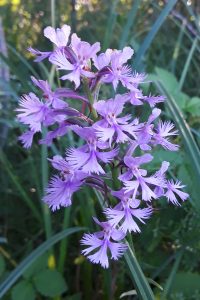Lesser Purple Fringed Orchid
 Platanthera psycodes flowers arrive July into August climbing a spike-like raceme up to 10″ long, in partly shady or sunny, moist habitats such as wet meadows and shorelines. Flowers consist of 2 petal-like sepals hooded above the fringed and deeply lobed lower lip which fades from white with two, fringed side petals. The leaves are oval to elliptic with a pointed tip, starting out about 8″ long and 2″ wide at the base of the plant and getting smaller as they ascend the stem.
Platanthera psycodes flowers arrive July into August climbing a spike-like raceme up to 10″ long, in partly shady or sunny, moist habitats such as wet meadows and shorelines. Flowers consist of 2 petal-like sepals hooded above the fringed and deeply lobed lower lip which fades from white with two, fringed side petals. The leaves are oval to elliptic with a pointed tip, starting out about 8″ long and 2″ wide at the base of the plant and getting smaller as they ascend the stem.
A real orchid in our woods, they appear like the wings of angels, fairies or butterflies presenting themselves from every direction as if in the midst of a dance. The name ‘psycodes’ comes from the Greek, ψυχη (psychi), translating as ‘soul’, which in Ancient Greece came to be personified as a butterfly. The Greek goddess, Psyche, is depicted this way as she goes through her trials and tribulations for love which in the end, it has been said, redeems her soul.
How quietly this beauty caught my attention as I walked the trail along the edge of the moist, shady area this orchid prefers!
The lesser purple fringed orchid can never be transplanted from its home in the woods, for it relies on a special, symbiotic relationship with the soil among its roots. Besides producing sweet nectar that collects in the spur at the back of the flower (and available to pollinators), this orchid photosynthesizes sugars it also feeds directly to the fungi growing in the soil beneath. In return, the fungi supply water and minerals such as phosphorous to the orchid plant in a delicate, mutually beneficial arrangement.
